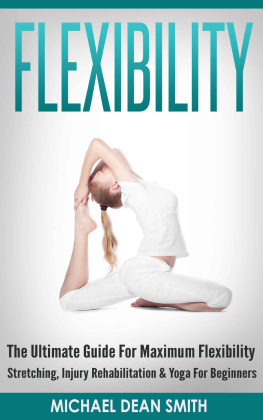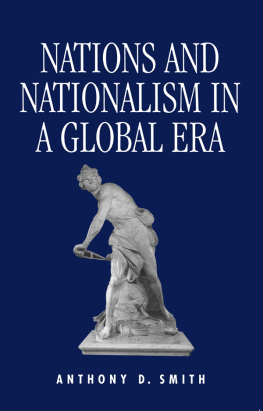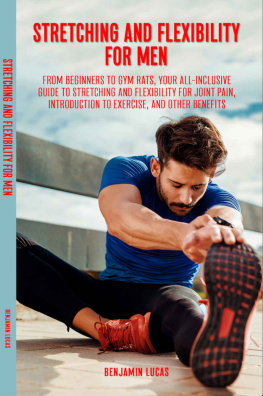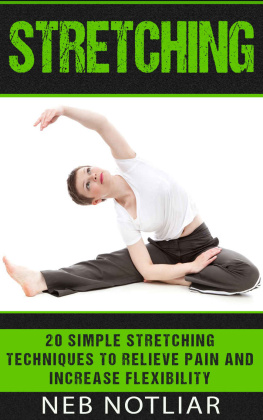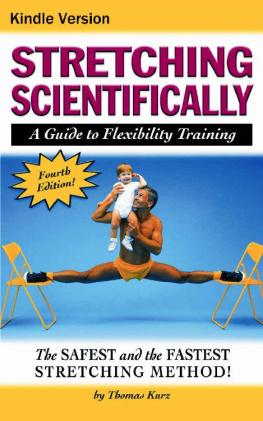FLEXIBILITY
The Ultimate Guide for Maximum Flexibility - Stretching, Injury Rehabilitation & Yoga for Beginners
Copyright 2015 - All rights reserved.
In no way is it legal to reproduce, duplicate, or transmit any part of this document in either electronic means or in printed format. Recording of this publication is strictly prohibited and any storage of this document is not allowed unless with written permission from the publisher. All rights reserved.
The information provided herein is stated to be truthful and consistent, in that any liability, in terms of inattention or otherwise, by any usage or abuse of any policies, processes, or directions contained within is the solitary and utter responsibility of the recipient reader. Under no circumstances will any legal responsibility or blame be held against the publisher for any reparation, damages, or monetary loss due to the information herein, either directly or indirectly.
Respective authors own all copyrights not held by the publisher.
Legal Notice:
This book is copyright protected. This is only for personal use. You cannot amend, distribute, sell, use, quote or paraphrase any part or the content within this book without the consent of the author or copyright owner. Legal action will be pursued if this is breached.
Disclaimer Notice:
Please note the information contained within this document is for educational and entertainment purposes only. Every attempt has been made to provide accurate, up to date and reliable complete information. No warranties of any kind are expressed or implied. Readers acknowledge that the author is not engaging in the rendering of legal, financial, medical or professional advice.
By reading this document, the reader agrees that under no circumstances are we responsible for any losses, direct or indirect, which are incurred as a result of the use of information contained within this document, including, but not limited to, errors, omissions, or inaccuracies.
Table of Contents
Introduction
This book contains a lot of useful information on how to attain optimum flexibility through proper stretching exercises. It will also guide you in connection with how to avoid injuries while stretching and what specific body parts are needed to be stretched.
Whether for sports, arts or everyday life, safe stretching will be a great help in attaining a healthy and flexible body. What you may not know is that without exercise, your body will get less flexible and that you will have difficulty as you get older that you could have avoided had you taken to exercises that encourage flexibility.
Your body will respond in a very positive manner once you start to understand what flexibility is all about. Yoga is a great way forward which gradually helps you to incorporate flexibility into your everyday routine, slowly learning to stretch different parts of the body to create perfect balance.
Read on and you will find the book is loaded with information that can help you achieve maximum flexibility.
The Importance of Flexibility
When you hear the word flexibility, what comes to your mind most probably would be the actions of a gymnast, ballet dancer or a martial artist who can lift his foot over his head with ease and perform full leg splits without any problem.
While most seasoned athletes can do all of those feats, theres more to flexibility than legs spread at 180 degrees or someones head touching his knees without them bending.
Science defines flexibility as the range of motion of a certain body. This range of motion refers to that of both the joints and muscle tissues. For a body to function with less limitation, good flexibility should be attained. This is important among many athletes because some sports require the body to move rapidly and explosively. When the body is not flexible, injuries may occur if the body does a maneuver that may twist or stretch muscle fibers that are not too flexible.
For joints, poor flexibility may cause the joints to dislocate when they are turned to sides where they dont usually go. For gymnasts, ballet dancers and martial artists of certain styles, maximum flexibility is required to be able to execute a routine or technique perfectly. For gymnasts, max flexibility allows them to execute multiple somersaults rapidly and land on their legs. In such executions, flexibility of the mid-section is important as well as that of the legs.
For martial artists, proper flexibility is important to be able to execute techniques fast without loss of momentum. Poor flexibility in this case may cause the muscle fibers to pull the limb and keep it from extending further, resulting in reduced power due to antagonist resistance and poor execution of the technique.
Besides artists and athletes, contortionists, stuntmen and other jobs require maximum flexibility to be able the workers to perform at their best. For them, stretching is a main part of their work and it is very important to keep their job uninjured.
Circus contortionists bend their bodies to an extraordinary extent which makes them popular with fans. They are able to shift muscle groups and joints in order to pass through a hole as small as a tennis rackets diameter. They can also bend their limbs far enough to be able to fit inside a small box- in a painless yet impressive way.
Stuntmen are the uncrowned best actors of every film. They act as doubles of the actors to perform dangerous maneuvers which can be very risky, sometimes deadly, for common actors and actresses especially if they are not physically trained for such stunts.
Stuntmen may not be as popular as the actors, but they do the more difficult jobs in a movie and get paid for it. To be able to execute a dangerous move safely, stuntmen need to be very athletic and their flexibility should be above average.
Because of this, stretching is a part of their everyday workout together with weight and endurance training.
If your passion requires you to use your full range of motion, stretching should be a part of your everyday life. Whether you use it for your job, sport, art, or just to have fun, overall flexibility is important and stretching is the only way you can get it.
Stretching: Flexibility for Speed
and Power
There are many sports and activities that require athletes to be powerful and fast in order to win in a competition. Besides the usual weight training and speed training, they stretch their muscles to gain their maximum flexibility, but why?
If some sports focus on athletes using speed or power, why do the same athletes need to be flexible?
The answer is quite simple: when muscles are limber and joints are flexible, less effort is exerted when extending the limbs or performing complex movements. Practitioners of martial arts are able to perform techniques without much effort.
Since the muscles are already flexible enough, there will be no more muscle fibers that will limit the extension of a limb when executing the technique.
With such freedom of movement, the force of the technique is fully transferred to the target and the joints and muscles are not much, if not at all, strained after execution. Flexibility for runners is just as important. Increased flexibility of the legs allows for faster and wider strides with less effort and antagonistic resistance.
So if flexibility is very important for athletes and participants of certain activities, how can your improve it? There are lots of exercises you can do to improve and maximize the potential range of motion of a certain joint or muscle group.
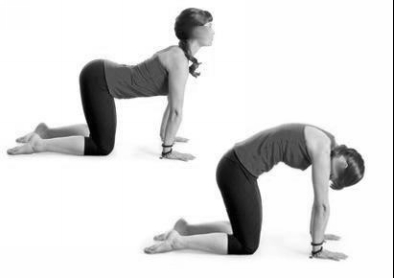
Neck and Torso Flexibility
For the upper body alone, you have to stretch several muscle groups to improve the flexibility of that area. The following are some stretching exercises to improve the range of motion of specific parts of the body: Back Muscles Being one of the most injury-prone parts of the body, the back should be properly stretched in order to withstand dangerous twists and maneuvers that normal people simply cannot. Regular stretching of the back can help you keep your muscles maintain their maximum range of motion and suppleness of the spinal column.
Next page
